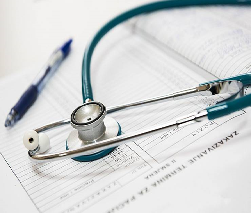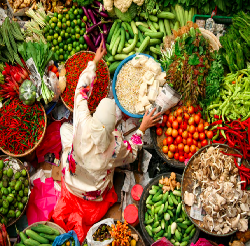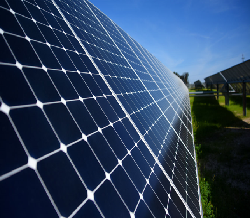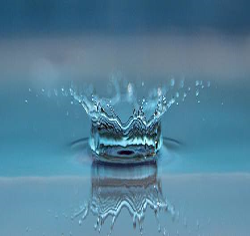Focus 2019 Sustainable Development
Read the articles selected for the Sustainable Development Festival 2019
SDGs 14, 15
La ONU pide medidas urgentes ante el desastro medioambiental
By Manuel Planelles Esther Sánchez
Source: El País, 14 March
Air pollution, reduction in fresh water, loss in biodiversity are the major environmental problems identified in the ONU’s GEO report calling Governments for urgent and radical measures, since the progress made in the direction of the Paris Agreement and the 2030 Agenda are too slow.
SDG 14
Climate change will raise mosquito risk
By Emily Holden
Source: The Guardian, 29 March
After a study published in PLOS Neglected Tropical Diseases the hotter temperatures risk to cause the spread of diseases transmitted by mosquitos that could kill more than a half billion people within 30 years, unless global warming is stopped.
SDG 14
Plummeting number of insects threatens “catastrophe for planet”
By Damian Carrington
Source: The Guardian, 11 February
Insects are the most various and abundant animal species in the Planet. Intensive agriculture, urbanization and climate change are causing a mass extinction, which affects all the forms of life and threatens in a few decades even the human survival.
SDGs 14, 15
Microplastics are blowing in the wind
By Andrea Thompson
Source: Scientific American, 15 April

Plastics is falling down like rain. A study published in Nature Geoscience reveals the discovery of polymers in microparticles in the Pyrenees, transported there by atmospheric currents coming from areas more populated and distant of the Planet.
Read more:
https://www.scientificamerican.com/article/microplastics-are-blowing-in-the-wind/
SDGs 14, 15
Frontiers 2018/2019
Source: UN Environment
Synthetic biology is a tool which reduces the environmental impact of the industrial production and helps to fight diseases, but presents also imprevedible and irreversible risks, both environmental and geopolitical, requiring therefore good governance and a responsible use.
Read more:
https://wedocs.unep.org/bitstream/handle/20.500.11822/27538/Frontiers1819.pdf?sequence=1&isAllowed=y
SDG 15
More than 75% decline over 27 years in total flying insect biomass in protected areas
By Caspar A. Hallmann etc.
Source: PLOS
The decline in insect biodiversity and abundance, as a result of the deterioration of habitat quality due to climate change has direct consequences on the echosystem's fundamental processes. It’s of outmost importance to know the mass of this decline for the assessment of biodiversity conservation and the echosystem’s health.
Read more:
https://journals.plos.org/plosone/article?id=10.1371/journal.pone.0185809
SDGs 15, 16
Enabling effective and equitable marine protected areas
Source: https://wedocs.unep.org
This guide draws from case studies about marine protected areas as example of governance for a sustainable conservation and sharing of marine resources, showing how the participation and the inclusion in the local decisional processes of the most disadvantaged groups makes a better environmental governance.
Read more:
https://wedocs.unep.org/bitstream/handle/20.500.11822/27790/MPA.pdf?sequence=1&isAllowed=y
SDGs 3, 16
Tracking Universal Health Coverage
Source: WHO & World Bank

Universal health coverage is not only a human right, but also an investment in human capital, as it is shown by the intersection of the SDGs. In the lack of precise data on this point, it’s important to promote the commitment of countries to measuring their progress through key indicators.
Read more:
http://documents.worldbank.org/curated/en/640121513095868125/pdf/122029-WP-REVISED-PUBLIC.pdf
SDG 3
Health at a Glance: Europe 2018
Source: oecd.org
This report , a result of the close collaboration with the EC, highlights the importance to point out to pay more attention to the mental health and reduce the waste of money in this sector, taking into account the increased expectation of life, corresponding the higher level of education
Read more:
SDGs 3, 10
About Health 2020
Source: https://www.who.int/
The health is the first condition to realize the full potential of every person. Health 2020 is an European framework programme studied to improve the public health and reduce the inequalities in the access to healthcare.
Read more:
SDGs 3, 2, 12
La dieta perfecta para salvar el planeta y la salud del ser humano
By M. Planelles & L. Delle Femmine
Source: El País, 17 January
A panel of experts by the journal Lancet has elaborated a model of healthy nutrition, good for both humans and the environment, which requires a farming revolution and a deep change in our habits, to be realized with the collaboration of all involved actors, including the consumers.
SDGs 3, 2, 13
The EAT-Lancet Commission on Food, Planet, Health
Source: http://asvis.it

Food has the power to condition both the human and the environmental health. Food production is the first factor responsible for environmental degradation. A plant- based nutrition with fewer animal proteins promises to be the source of welfare for all the living beings and the driver of a cultural and societal change.
Read more:
https://eatforum.org/content/uploads/2019/01/EAT-Lancet_Commission_Summary_Report.pdf
SDG 1
Global Economic Prospects
Source: World Bank Group
This report outlooks the global progress of the emerging markets and developing economies, highlighting the effects of this precarious economic juncture, given by hot trade tensions, financial stress and risks, that don’t contribute to a macroeconomic stability and hence to a sustained a sustainable growth.
Read more:
SDG 1
Financing Climate Futures
Source: http://www.oecd.org/
This paper, cowritten by the Oecd, the UN Environment and the World Bank highlights the need for a global trasformation, made of planning, innovation, finance, development in all the foundations of our civilisation.
Read more
https://read.oecd-ilibrary.org/environment/financing-climate-futures_9789264308114-en#page1
SDGs 1, 3, 10, 13
Unequal exposure and unequal impacts: social vulnerability to air pollution, noise and extreme temperatures in Europe
Source: European Environment Agency
There are remarkable, both regional and social differences in the esposure to environmental risks in Europe, as well as in our ability to cope with them. More coherence between health, poverty and climate policies while focusing on vulnerable groups could bring benefits to the public health.
Read more:
file:///C:/Users/Roberta%20Capo/Downloads/TH-AL-18-022-EN-1%20Unequal%20exposure.pdf
SDG 1
Inclusive Wealth Report
Source: UN Environment
A country’s inclusive wealth is the social value of all its capital assets, which assesses if a country’s economic growth is sustainable, beyond the 2030 end line, how the natural capital is exploited and how the wealth is shared among the population.
Read more:
SDGs 1, 3
Building a tubercolosis-free world: the Lancet Commission on tubercolosis
Source: The Lancet, 20 March
The tubercolosis is the infection most mortal and widespread in the world. Given the relation between the disease, poverty and underdevelopment, it requires not only more research funding but also a global political effort toward the achievement of the SDGs, as declared at the UN High-Level Meeting on tubercolosis.
Read more:
https://www.thelancet.com/pdfs/journals/lancet/PIIS0140-6736(19)30024-8.pdf
SDGs 1, 8, 10
World Employment Social Outlook
Source: ILO
This report presents the situation of the workers in the world in the articulated meaning of the SDG8 in terms, both objective and subjective, of prosperity and well-being. While the definition of work evolves in the time, it remains the concrete measure for the principles of equality, democracy, sustainability and social cohesion.
Read more:
SDG 7
Emissions Gap Report
Source: UN Environment

Current national committments to comply with Paris Agreement on climate change are very far from its goal to stay under 2°C temperature increase , and though it is still possible, in fact, the global CO2 emissions show that the perspective of exceeding 1.5°C global warming is more realistic than the efforts deployed on global scale.
Read more:
https://www.unenvironment.org/resources/emissions-gap-report-2018
SDG 7
The thrillion-dollar question: how can we unlock the money needed to transition to a low-carbon economy?
By Geraldine Ang
Source: oecd.org

This crucial question is to be translated into how to attract private sources of capital in support of the transition to a low-carbon economy, since public finance alone cannot face all the infrastructure investments needed. Governments and public institutions should start mobilizing private sources of capital.
Read more:
SDG 7
How to win public support for a global carbon tax
By Stefano Carattini, Steffen Kallbekken&Anton Orlov
Source: Nature, 16 January
Taxes on carbon are an effective strategy to cut greenhouse gases, but they aren’t generally well welcomed by the public opinion. Public support depends on their design. Implementing carbon-pricing gradually and a harmonized distribution of its revenues are the key of success.
Read more:
https://www.nature.com/articles/d41586-019-00124-x
SDG 7
The Clean technology Fund and Concessional Finance
Source: Bloomberg NEF
The success of the Clean Technology Fund in lowering the cost of capital of renewables has changed the economics of clean energy and strengthened the role of finance in promoting the production and consumption of zero-carbon energy.
Read more:
SDG 7
Internet of Things: Energy boon or bane?
By Eric Hittinger & Paulina Jaramillo
Source: Science, 26 April
Another revolution will happen in our lives, and it will have to reckon with the consumption of energy. The Internet of Things not only will have a direct impact on the systems of energy, but will also bring to a multiplied use of devices and services..
Read more:
https://science.sciencemag.org/content/364/6438/326
SDG 7
New fuel cell could help fix the renewable energy storage problem
By Robert F. Service
Source: Science, 12 March
The shift to the renewables could be achieved at low cost through new cells created to store in a long term the electricity produced in excess from solar and wind energy, converting it in chemical fuel, to change it back in electricity available for the consumption.
Read more:
SDG 6
How humans get in the way of clean water
By Lindzi Vessel
Source: Scientific American, 26 January

Household technology can deliver drinking water in emergencies to the poorest regions of the world. Superficiality and cultural barriers hinder things to change through the harnessing of every resource and knowledge whenever governments policies are impotent.
Read more:
https://www.scientificamerican.com/article/how-humans-get-in-the-way-of-clean-water/
SDG 6
World Water Development Report 2019
Source: the United Nations

In the 2030 Agenda, nothing like the right to water and sanitation is so essential to human health and dignity and touches on the most vulnerable and discriminated people, and is therefore at the hearth of the human rights. The international law obliges States to create the conditions for an universal access to hydric services.
Read more:
https://unesdoc.unesco.org/ark:/48223/pf0000367303
Info
-
Pubblicato il :
29/05/2019
Modificato il : 29/05/2019

